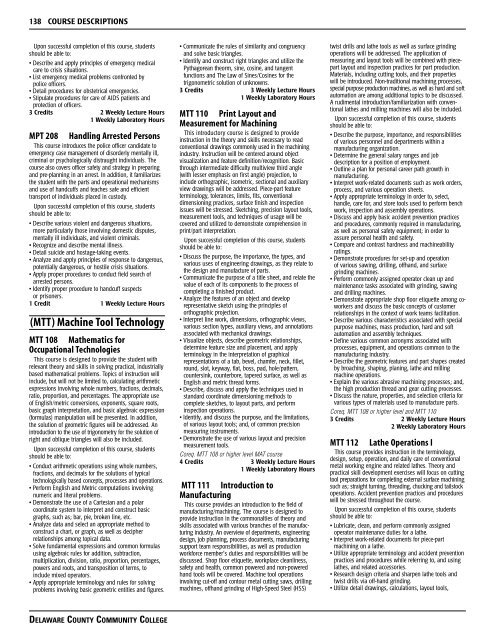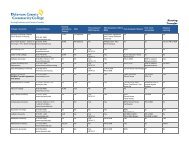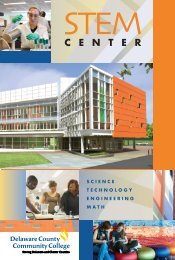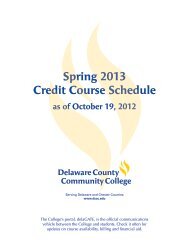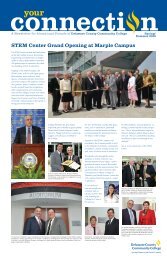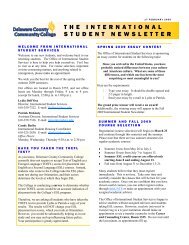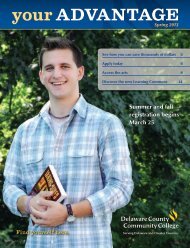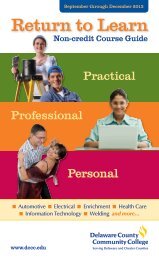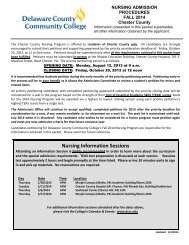2010 Catalog - Delaware County Community College
2010 Catalog - Delaware County Community College
2010 Catalog - Delaware County Community College
Create successful ePaper yourself
Turn your PDF publications into a flip-book with our unique Google optimized e-Paper software.
138 COURSE DESCRIPTIONS<br />
Upon successful completion of this course, students<br />
should be able to:<br />
• Describe and apply principles of emergency medical<br />
care to crisis situations.<br />
• List emergency medical problems confronted by<br />
police officers.<br />
• Detail procedures for obstetrical emergencies.<br />
• Stipulate procedures for care of AIDS patients and<br />
protection of officers.<br />
3 Credits 2 Weekly Lecture Hours<br />
1 Weekly Laboratory Hours<br />
MPT 208<br />
Handling Arrested Persons<br />
This course introduces the police officer candidate to<br />
emergency case management of disorderly mentally ill,<br />
criminal or psychologically distraught individuals. The<br />
course also covers officer safety and strategy in preparing<br />
and pre-planning in an arrest. In addition, it familiarizes<br />
the student with the parts and operational mechanisms<br />
and use of handcuffs and teaches safe and efficient<br />
transport of individuals placed in custody.<br />
Upon successful completion of this course, students<br />
should be able to:<br />
• Describe various violent and dangerous situations,<br />
more particularly those involving domestic disputes,<br />
mentally ill individuals, and violent criminals.<br />
• Recognize and describe mental illness.<br />
• Detail suicide and hostage-taking events.<br />
• Analyze and apply principles of response to dangerous,<br />
potentially dangerous, or hostile crisis situations.<br />
• Apply proper procedures to conduct field search of<br />
arrested persons.<br />
• Identify proper procedure to handcuff suspects<br />
or prisoners.<br />
1 Credit 1 Weekly Lecture Hours<br />
(MTT) Machine Tool Technology<br />
MTT 108 Mathematics for<br />
Occupational Technologies<br />
This course is designed to provide the student with<br />
relevant theory and skills in solving practical, industrially<br />
based mathematical problems. Topics of instruction will<br />
include, but will not be limited to, calculating arithmetic<br />
expressions involving whole numbers, fractions, decimals,<br />
ratio, proportion, and percentages. The appropriate use<br />
of English/metric conversions, exponents, square roots,<br />
basic graph interpretation, and basic algebraic expression<br />
(formulas) manipulation will be presented. In addition,<br />
the solution of geometric figures will be addressed. An<br />
introduction to the use of trigonometry for the solution of<br />
right and oblique triangles will also be included.<br />
Upon successful completion of this course, students<br />
should be able to:<br />
• Conduct arithmetic operations using whole numbers,<br />
fractions, and decimals for the solutions of typical<br />
technologically based concepts, processes and operations.<br />
• Perform English and Metric computations involving<br />
numeric and literal problems.<br />
• Demonstrate the use of a Cartesian and a polar<br />
coordinate system to interpret and construct basic<br />
graphs, such as; bar, pie, broken line, etc.<br />
• Analyze data and select an appropriate method to<br />
construct a chart, or graph, as well as decipher<br />
relationships among topical data.<br />
• Solve fundamental expressions and common formulas<br />
using algebraic rules for addition, subtraction,<br />
multiplication, division, ratio, proportion, percentages,<br />
powers and roots, and transposition of terms, to<br />
include mixed operators.<br />
• Apply appropriate terminology and rules for solving<br />
problems involving basic geometric entities and figures.<br />
• Communicate the rules of similarity and congruency<br />
and solve basic triangles.<br />
• Identify and construct right triangles and utilize the<br />
Pythagorean theorm, sine, cosine, and tangent<br />
functions and The Law of Sines/Cosines for the<br />
trigonometric solution of unknowns.<br />
3 Credits 3 Weekly Lecture Hours<br />
1 Weekly Laboratory Hours<br />
MTT 110 Print Layout and<br />
Measurement for Machining<br />
This introductory course is designed to provide<br />
instruction in the theory and skills necessary to read<br />
conventional drawings commonly used in the machining<br />
industry. Instruction will be centered around object<br />
visualization and feature definition/recognition. Basic<br />
through intermediate difficulty multiview third angle<br />
(with lesser emphasis on first angle) projection, to<br />
include orthographic, isometric, sectional and auxiliary<br />
view drawings will be addressed. Piece-part feature<br />
terminology, tolerances, limits, fits, conventional<br />
dimensioning practices, surface finish and inspection<br />
issues will be stressed. Sketching, precision layout tools,<br />
measurement tools, and techniques of usage will be<br />
covered and utilized to demonstrate comprehension in<br />
print/part interpretation.<br />
Upon successful completion of this course, students<br />
should be able to:<br />
• Discuss the purpose, the importance, the types, and<br />
various uses of engineering drawings, as they relate to<br />
the design and manufacture of parts.<br />
• Communicate the purpose of a title sheet, and relate the<br />
value of each of its components to the process of<br />
completing a finished product.<br />
• Analyze the features of an object and develop<br />
representative sketch using the principles of<br />
orthographic projection.<br />
• Interpret line work, dimensions, orthographic views,<br />
various section types, auxiliary views, and annotations<br />
associated with mechanical drawings.<br />
• Visualize objects, describe geometric relationships,<br />
determine feature size and placement, and apply<br />
terminology in the interpretation of graphical<br />
representations of a tab, bevel, chamfer, neck, fillet,<br />
round, slot, keyway, flat, boss, pad, hole/pattern,<br />
countersink, counterbore, tapered surface, as well as<br />
English and metric thread forms.<br />
• Describe, discuss and apply the techniques used in<br />
standard coordinate dimensioning methods to<br />
complete sketches, to layout parts, and perform<br />
inspection operations.<br />
• Identify, and discuss the purpose, and the limitations,<br />
of various layout tools; and, of common precision<br />
measuring instruments.<br />
• Demonstrate the use of various layout and precision<br />
measurement tools.<br />
Coreq. MTT 108 or higher level MAT course<br />
4 Credits 3 Weekly Lecture Hours<br />
1 Weekly Laboratory Hours<br />
MTT 111<br />
Introduction to<br />
Manufacturing<br />
This course provides an introduction to the field of<br />
manufacturing/machining. The course is designed to<br />
provide instruction in the commonalties of theory and<br />
skills associated with various branches of the manufacturing<br />
industry. An overview of departments, engineering<br />
design, job planning, process documents, manufacturing<br />
support team responsibilities, as well as production<br />
workforce member's duties and responsibilities will be<br />
discussed. Shop floor etiquette, workplace cleanliness,<br />
safety and health, common powered and non-powered<br />
hand tools will be covered. Machine tool operations<br />
involving cut-off and contour metal cutting saws, drilling<br />
machines, offhand grinding of High-Speed Steel (HSS)<br />
twist drills and lathe tools as well as surface grinding<br />
operations will be addressed. The application of<br />
measuring and layout tools will be combined with piecepart<br />
layout and inspection practices for part production.<br />
Materials, including cutting tools, and their properties<br />
will be introduced. Non-traditional machining processes,<br />
special purpose production machines, as well as hard and soft<br />
automation are among additional topics to be discussed.<br />
A rudimental introduction/familiarization with conventional<br />
lathes and milling machines will also be included.<br />
Upon successful completion of this course, students<br />
should be able to:<br />
• Describe the purpose, importance, and responsibilities<br />
of various personnel and departments within a<br />
manufacturing organization.<br />
• Determine the general salary ranges and job<br />
description for a position of employment.<br />
• Outline a plan for personal career path growth in<br />
manufacturing.<br />
• Interpret work-related documents such as work orders,<br />
process, and various operation sheets.<br />
• Apply appropriate terminology in order to, select,<br />
handle, care for, and store tools used to perform bench<br />
work, inspection and assembly operations.<br />
• Discuss and apply basic accident prevention practices<br />
and procedures, commonly required in manufacturing,<br />
as well as personal safety equipment; in order to<br />
assure personal health and safety.<br />
• Compare and contrast hardness and machineability<br />
ratings.<br />
• Demonstrate procedures for set-up and operation<br />
of various sawing, drilling, offhand, and surface<br />
grinding machines.<br />
• Perform commonly assigned operator clean up and<br />
maintenance tasks associated with grinding, sawing<br />
and drilling machines.<br />
• Demonstrate appropriate shop floor etiquette among coworkers<br />
and discuss the basic concepts of customer<br />
relationships in the context of work teams facilitation.<br />
• Describe various characteristics associated with special<br />
purpose machines, mass production, hard and soft<br />
automation and assembly techniques.<br />
• Define various common acronyms associated with<br />
processes, equipment, and operations common to the<br />
manufacturing industry.<br />
• Describe the geometric features and part shapes created<br />
by broaching, shaping, planing, lathe and milling<br />
machine operations.<br />
• Explain the various abrasive machining processes; and,<br />
the high production thread and gear cutting processes.<br />
• Discuss the nature, properties, and selection criteria for<br />
various types of materials used to manufacture parts.<br />
Coreq. MTT 108 or higher level and MTT 110<br />
3 Credits 2 Weekly Lecture Hours<br />
2 Weekly Laboratory Hours<br />
MTT 112<br />
Lathe Operations I<br />
This course provides instruction in the terminology,<br />
design, setup, operation, and daily care of conventional<br />
metal working engine and related lathes. Theory and<br />
practical skill development exercises will focus on cutting<br />
tool preparations for completing external surface machining<br />
such as; straight turning, threading, chucking and tailstock<br />
operations. Accident prevention practices and procedures<br />
will be stressed throughout the course.<br />
Upon successful completion of this course, students<br />
should be able to:<br />
• Lubricate, clean, and perform commonly assigned<br />
operator maintenance duties for a lathe.<br />
• Interpret work-related documents for piece-part<br />
machining on a lathe.<br />
• Utilize appropriate terminology and accident prevention<br />
practices and procedures while referring to, and using<br />
lathes, and related accessories.<br />
• Research design criteria and sharpen lathe tools and<br />
twist drills via off-hand grinding.<br />
• Utilize detail drawings, calculations, layout tools,<br />
DELAWARE COUNTY COMMUNITY COLLEGE


